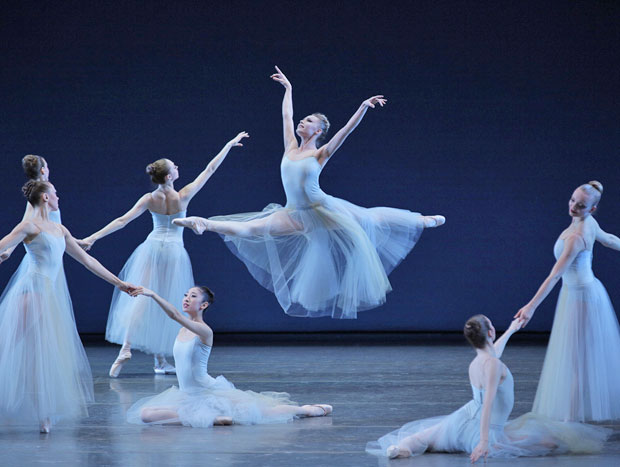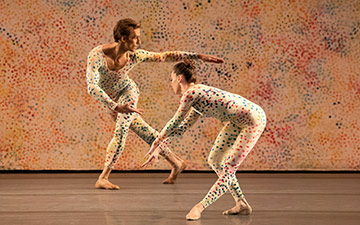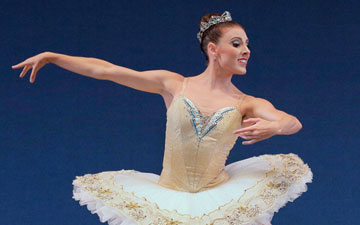
© Paul Kolnik. (Click image for larger version)
Tchaikovsky, Take One
New York City Ballet
Tchaikovsky Celebration: Serenade, Mozartiana, Tchaikovsky Piano Concerto No. 2
New York, David H. Koch Theater
16 January 2013
www.nycballet.com
I’m not yet fully convinced of the wisdom of New York City Ballet’s thematic seasons, organized around the music of a single composer. A full evening of Balanchine and Stravinsky is bracing and illuminating, but a whole season can leave you begging for melody, harmonic resolution, a drop of pathos. One can’t be acerbic and witty all the time. This season it’s Tchaikovsky’s turn, and the dial flips in the opposite direction, to a sound world filled with mystery, soaring melodies, turbulent crescendi and majestic apotheoses. In other words, a welcome injection of grandeur into our mundane lives. But how long can the audience sustain this fever pitch before beginning to yearn for the sharp edge of modernism? We’ll see.
Still, there is no arguing with the central role played by these two composers in Balanchine’s choreographic imagination. Many of his most striking, surprising works were made in response to music by Stravinsky (Agon, Symphony in Three Movements, to name just two). And many of his most stirring, visually alluring ballets were set to Tchaikovsky. Balanchine often spoke of how he identified with and was guided by Tchaikovsky’s spirit. The two men shared a connection to the world of the Russian Imperial court (in Balanchine’s case, to its death throes), a respect for classicism and a sense of the sublime, stemming in part from a deep religiosity. In fact, Balanchine felt so in tune with Tchaikovsky that on many occasions he took the liberty of changing his music to suit his own needs. He felt entitled to do so. In his Nutcracker he even inserted music from a completely different piece. Such tinkering is also a feature of two of the ballets in the opening program of New York City Ballet’s winter season. The whole season has been dubbed the “Tchaikovsky Celebration.”
Those ballets are Serenade and Mozartiana. (I caught the performance on Jan. 16). In both, Balanchine chose to move a slow, legato section from one place to another in order to create a specific emotional effect. In Serenade it’s the Elegie, which he placed at the end, setting the stage for one of the most transcendent images in all of ballet. (A woman is slowly carried off, hair loosened, on the shoulders of four men; as they advance, she slowly raises her arms and arches her back. It is an image of complete surrender to an unknown, overpowering force.) In Mozartiana, on the other hand, Balanchine moved the imploring, almost treacly Preghiera – the third movement of Tchaikovsky’s Suite No. 4 – to the beginning. (This was done in the 1981 reworking of the ballet, of which there were several previous versions.) Again, the re-ordering of the music sets the trajectory of the ballet, from darkness to light.

© Paul Kolnik. (Click image for larger version)
Last night, these musical underpinnings were expressively revealed under the baton of Roberto Minczuk, a Brazilian conductor of Russian extraction. This despite some ragged sounds in the orchestra later in the night. Even so the overall shape and emotional tone of the pieces were sustained throughout the evening. Fayçal Karoui, the former musical director at NYCB, was a fine conductor with a strong sense of musical architecture and rhythm, but he had no real feel for Tchaikovsky’s extremes of emotion. We got shape but no drama. But on this night, from the first notes of Serenade it was obvious that Minczuk was in tune with the composer’s spiritual dimension. The playing was dynamic, but it also had breadth, lushness, dramatic highs and lows; when needed, a pause was held for an extra beat, like the swell of a sob.
This emotional fullness didn’t always find its full reflection in the dancing, however. As I’ve commented in recent seasons, City Ballet does grandeur well, as well as coolness, speed, attack and urbanity. All of these qualities are indispensable in dancing Balanchine. But at the moment, poetry and delicacy do not seem to be high priorities. There are exceptions of course: particular dancers, like Tiler Peck and Lauren Lovette, who are able to communicate this quality of introspection in their dancing, spiked with a whiff of longing. It is a quality built out of contradictions: legato and light, urgent and timeless, plangent without being cloying. Balanchine’s Serenade is a modern reinterpretation of this ineffable quality – the quality of moonlight, of semi-transparency, of spectral bodies moving together with one breath. At the moment, Serenade has lost some of its poetry. It’s all in the details: in the very first image, when the dancers’ right arms are extended toward some unseen power, the angles are not quite the same. This is one moment when uniformity matters. The references to Giselle – traveling arabesques, swishing turns on flat feet – have lost their fateful thrust, their sense of turbulent powers at play. In the Russian Dance the image of these women as a delicate sisterhood, delicately tilting their heads together like Russian nursemaids, barely registers. It’s still beautiful, but not as powerful as it should be. Maybe the company simply dances this ballet too often?
Similarly, the three principals – Sara Mearns, Megan LeCrone and Ashley Bouder – seemed disconnected from each other and from the overall sweep of the ballet, though each danced well in her own right. Bouder, as one might expect, was all attack and brilliance in the so-called Russian Dance, each jump like a pistol shot, legs like daggers in the air. She also added hints of characterization; she’s such an intelligent dancer, and knows how to spice things up. Her bow at the end of the waltz section reminded me of a character in a play: “I bid you adieu, good people.” But such flourishes can’t replace real immersion in the mood. Sara Mearns, back after a long recovery from injury, was immersed in a drama of her own, her return to the stage after almost a year. It’s good to see her back, and she danced the role of the waltzing girl (a début), with great élan, if perhaps a touch too much force. Once her confidence returns she will surely find ways to infuse more nuance, less raw power, into the role. Megan LeCrone, also débuting, brought a convincing grandeur to the role of the dark angel in the Elegie.

© Paul Kolnik. (Click image for larger version)
It was a night of débuts. Sterling Hyltin danced the lead in Mozartiana for the first time, alongside Chase Finlay, also débuting. She didn’t overdo the prayerful Preghiera, which can so easily become mawkish. (The four little girls were lovely, as usual.) Hyltin ended the section with a series of breathtaking backward bourrées, her feet a blur, body propelled by an external force. Anthony Huxley’s Gigue was elegant and precise, danced with such finesse that the steps seemed almost ironic, like the brilliant patter of a courtier. His exquisite phrasing banishes all cuteness from the role. Then came the glorious theme and variations, based on Mozart’s Variations on a Theme by Gluck. (All of the music in Mozartiana is drawn from Mozart piano works, which is probably why it has such a bright, graceful tone.) These variations, in which the two principals alternate, contain some of Balanchine’s wittiest, and most devilishly difficult, petit allegro choreography. Hyltin was more than up to the task, displaying enormous charm and femininity, as well as a sense of humor and fine-tuned musicality. She used all of her tools, holding her head just so, giving an extra twist to her shoulders and hips, imbuing her footwork with a witty sparkle. Finlay was a great foil, manly and noble, with a deep, luscious plié and cat-like jump. Each variation, accompanied by a different instrument, has its own tone, reflected in the choreography. As they increased in difficulty, Hyltin became more expansive, more free; Finlay tired slightly toward the end, but who can blame him? The ballet is a dazzling display of technique and wit.
The night ended with Tchaikovsky Piano Concerto No. 2, originally known as Ballet Imperial. Like the two other ballets on the program it has a special significance. Serenade was the first ballet Balanchine made in America (in 1935); Mozartiana, from 1981, was his last major work (made two years before his death). And Ballet Imperial, choreographed for Lincoln Kirstein’s Ballet Caravan (in 1941), was his first foray into the Petipa style, the first of many. For Balanchine it was a return to the grandeur and pageantry he had known, if only briefly, as a student at the Imperial ballet school, before all hell broke loose. He took to the Imperial style like a fish to water, it seems. The profusion of patterns, rushing across the stage in intercrossing lines, circles, diamonds, diagonals, feels as natural as breathing.

© Paul Kolnik. (Click image for larger version)
The company looked splendid here, from corps to principals. Ana Sophia Scheller, débuting in the soloist role, dispatched her bravura steps with enormous aplomb, as she always does. But the greatest praise goes to Teresa Reichlen, who danced the role of the queen-like ballerina with such luxurious grace, such natural musicality and such easy self-possession that she seemed to exist in a dimension all her own. She glided through the steps, without the least effort or strain, each phrase of movement finishing just as the final note of the phrase was ringing out in the orchestra. It was the kind of total command that transcends technique. All one could do was watch in amazement.

















[…] New York City Ballet’s winter season (aka the “Tchaikovsky Celebration”) opened this week. I caught the Wednesday performance, with Serenade, Mozartiana, and Tchaikovsky Piano Concerto No. 2 (once known as Ballet Imperial). It also marked Sara Mearns’ return to the stage, after a long injury. You can read my review of the performance, for DanceTabs, here. […]
Really nice writing by someone who knows what she’s talking about. I like your intelligence and insight.
Thank you, Mr. Blackmore-Dobbyn!